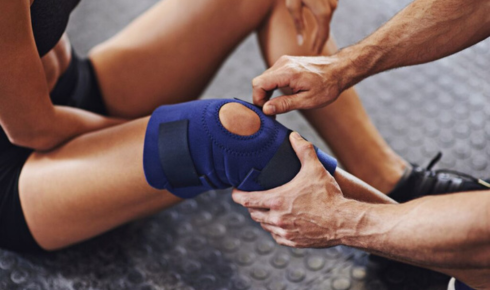Joint injuries can feel like they set everything back. Whether it’s from a quick pivot on the court or a misstep during a run, sprains demand the right treatment to ensure long-term recovery. A trusted sports medicine doctor doesn’t just treat the pain—they rebuild strength, coordination, and stability from the inside out.
Gradual Load Progression to Restore Ligament Function Safely
Restoring a sprained ligament doesn’t mean complete rest. Instead, sports medicine professionals introduce gradual load progression to guide the tissue through healing without causing re-injury. This process begins with light isometric exercises that don’t strain the joint but allow the ligament to remain engaged. Over time, weight-bearing movements are carefully reintroduced to help the tissue adapt to stress again.
One reason this method works well is because ligaments respond to mechanical stimulation. A trained orthopedic sports medicine specialist uses specific progressions—like resistance band steps or controlled lunges—to ensure the load remains within the healing threshold. By adjusting intensity and frequency based on individual progress, function returns without creating setbacks.
Manual Therapy Techniques to Improve Joint Mobility Post-sprain
Following a sprain, restricted joint mobility becomes a major obstacle. Manual therapy techniques focus on mobilizing the joint capsule and surrounding tissues that often stiffen during the injury. Techniques such as joint glides, passive range-of-motion movements, and soft tissue release break up adhesions and allow freer joint movement.
These hands-on approaches also stimulate mechanoreceptors in the ligaments and tendons, which support proprioception—the body’s sense of movement and balance. A sports medicine doctor near me might use these techniques multiple times per week early in recovery. This reintroduces motion to the joint gradually and reduces long-term stiffness that could otherwise limit performance.
Controlled Balance Drills Used to Reestablish Ankle Stability
Sprained ankles compromise more than the ligaments—they disrupt the body’s ability to stay upright under sudden shifts. Controlled balance drills retrain the body to respond quickly and efficiently. Starting with stable surfaces and single-leg stances, the drills progress to wobble boards, foam pads, or dynamic surfaces to challenge balance systems.
The goal is to retrain the neuromuscular system to react appropriately in unpredictable conditions. These drills also re-engage stabilizing muscles around the joint, which often become dormant after injury. A sports medicine doctor focuses on precision, often cueing patients to align posture and activate deep foot and leg musculature during these exercises.
Compression and Offloading Strategies for Early Tissue Recovery
Managing swelling and tissue overload plays a big role in early recovery. Compression sleeves or wraps help control inflammation by limiting excess fluid buildup in the joint space. This improves circulation and allows damaged tissues to receive nutrients more efficiently. Many sports medicine specialists pair compression with intermittent elevation to reduce pooling in the injured area.
Offloading techniques—like crutches, walking boots, or partial weight-bearing protocols—protect healing structures in the first few days. These tools are not meant to limit movement entirely but to support tissue while it rebuilds. Once inflammation reduces, offloading transitions to more active recovery, allowing controlled stress without risking re-injury.
Neuromuscular Re-education to Prevent Repeat Sprains
Sprains often leave behind faulty movement patterns. Neuromuscular re-education targets the brain-to-muscle communication pathways that guide coordination. Using cues, resistance, and proprioceptive input, sports medicine specialists retrain the body to activate the correct muscles in proper sequence. This phase of rehab is essential for reducing the risk of recurrence.
Exercises might include step-down drills, agility ladder movements, or resisted lateral hops. Rather than focusing solely on strength, these drills emphasize timing and reaction. An orthopedic sports medicine provider adjusts difficulty to match the athlete’s needs, making sure the brain and body are synchronized before returning to full play.
Ultrasound and Cold Therapy Applications in Acute Phases
During the first 48 to 72 hours of a sprain, controlling inflammation and minimizing pain is key. Cold therapy—whether through ice packs, cryo cuffs, or contrast baths—is a go-to for reducing swelling and nerve sensitivity. When applied correctly, it decreases cellular damage and speeds up initial recovery.
Ultrasound therapy is another technique often applied by a sports medicine doctor near me. It delivers sound waves into the tissue, which stimulates blood flow and promotes soft tissue healing. In acute injuries, pulsed ultrasound settings minimize heat while still promoting repair at the cellular level. These tools are used strategically to support healing without overloading the injured joint.
Bracing Support Used During Return-to-play Planning
As the athlete nears return-to-play status, external support helps bridge the gap between rehab and performance. Functional braces provide stability without completely restricting motion. A sports medicine doctor will choose a brace that suits the demands of the athlete’s sport—whether it’s hinged ankle braces for court play or compression sleeves for runners. Bracing also adds a layer of confidence. Athletes recovering from sprains often hesitate during high-impact movements. Wearing a properly fitted brace during this phase reduces mental and physical hesitation, giving the body time to rebuild natural stability. It’s a short-term measure that aids the final stages of recovery.
Stepwise Taping Methods to Reinforce Healing Structures
Taping techniques serve a different role than bracing. Rather than simply supporting, stepwise taping methods are used to guide motion and remind muscles to activate correctly. A sports medicine doctor applies specific patterns—like stirrups, anchors, or heel locks—to mimic ligament support and control joint angles during movement.
Over time, taping can be scaled back as strength and control improve. For athletes who need both mobility and feedback, taping becomes a valuable tool during training sessions or early return to play. The key lies in customizing the method to the sprain location, sport demands, and healing stage. These subtle corrections reinforce proper mechanics while encouraging the body’s systems to take over naturally.




